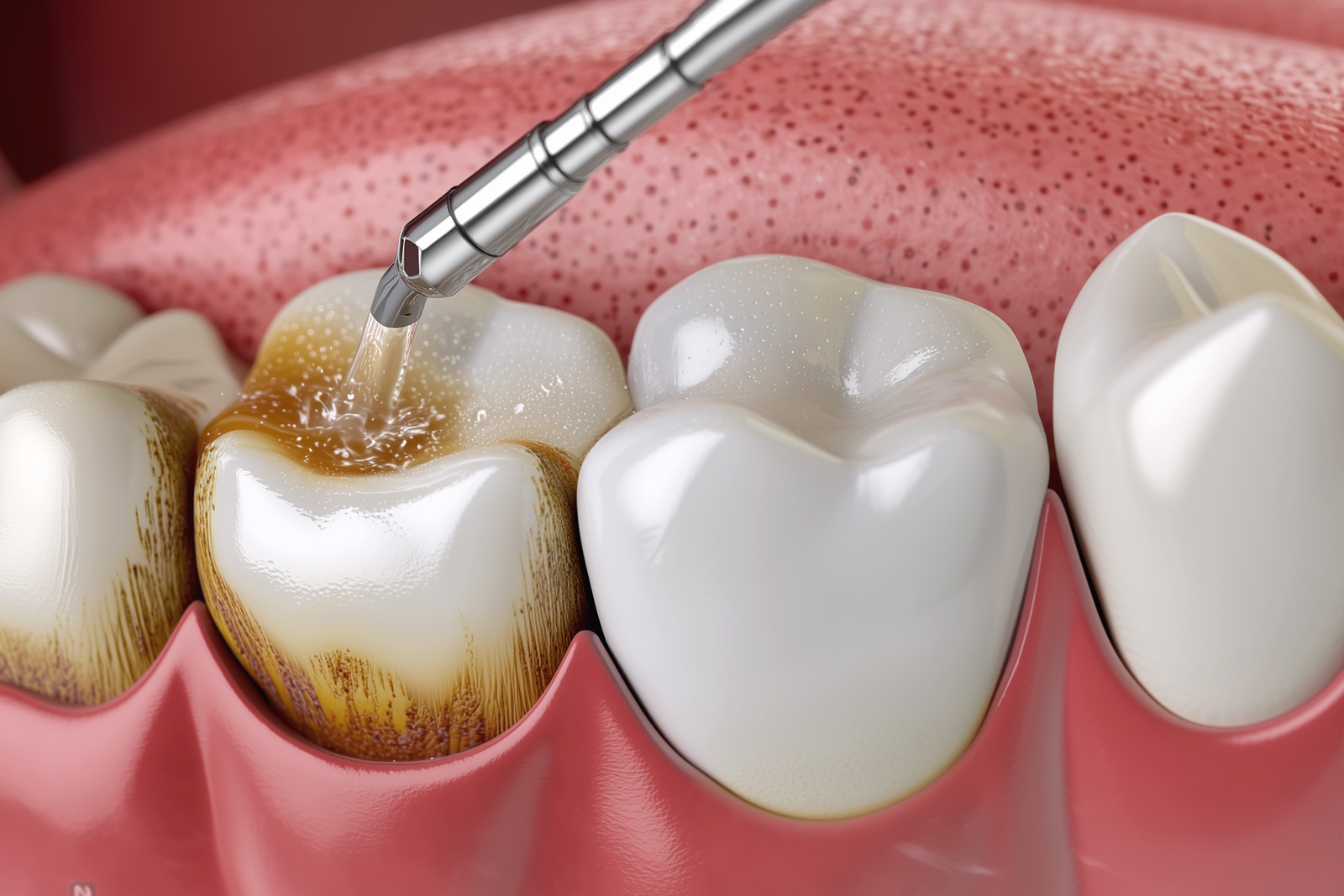Cleaning of dental tartar
For individuals dealing with plaque buildup, tartar cleaning is essential for maintaining oral health and aesthetics

Dental tartar, which forms from mineralized plaque, requires professional removal to preserve results and reduce the risk of more serious health issues related to the oral cavity.
What is dental tartar and how does It form?
Dental tartar is a hard, calcified form of plaque that forms on teeth and can form both above and below the gum line.
The deposits above the gum line are visible and easier to remove, while the deposits below the gums are more harmful, as they are harder to access and can directly affect gum health and the supporting structures of the teeth.
Regular brushing, flossing, and professional cleaning at the dentist are key to preventing and removing tartar.
Benefits of tartar removal
- Prevents the development of periodontal diseases
- Reduces the risk of cavities
- Improves breath freshness
- Maintains the aesthetics of teeth
- Helps preserve overall oral health
Who are candidates for tartar cleaning?
Tartar cleaning is recommended for individuals who:
- Have visible tartar deposits
- Consume tobacco products
- Have a history of periodontal diseases
- Have very dry mouths (xerostomia)
- Have worn orthodontic braces
- Regularly consume foods rich in sugars and starches
What is the procedure for removing dental tartar?
The tartar removal procedure involves several steps to ensure thorough cleaning of the teeth and preservation of oral health.
1. Visit – consultation, examination, and diagnosis
- A dental examination and assessment of the patient's oral health
- X-ray imaging may be used to provide a detailed view of the condition below the gum line and between the teeth, where tartar is harder to see.
- Assessment and planning – the dentist evaluates the depth and extent of the deposits and plans the cleaning method, such as manual scraping or ultrasonic cleaning.
Professional cleaning – tartar removal
- Ultrasonic cleaning: An ultrasonic device is used to break up dental tartar using vibrations without damaging the enamel.
- Manual scraping: The dentist uses specialized instruments to remove stubborn deposits from the surface of the teeth and below the gum line.
- Polishing: After all the tartar has been removed, the teeth are polished with special pastes that smooth the surface of the teeth, reducing the chance of plaque buildup.
- Fluoride treatment (optional): A fluoride treatment may be applied to strengthen the enamel and provide additional protection against cavities.
2. Visit – follow-up appointments and maintenance
- Regular follow-up appointments – It is recommended to arrange regular visits every 6 months
to monitor oral health and address any new deposits or dental issues in a timely manner.
Cleaning dental tartar is a crucial procedure for maintaining oral health and preventing periodontal diseases.
Maintaining oral hygiene at home is very important, but only professional cleaning can completely remove dental tartar.
Regular visits to the dentist, proper oral hygiene, and adjustments to dietary habits are key to the health of your teeth and gums.
The tartar cleaning procedure typically involves one or more visits to the dentist, depending on the amount of tartar and the patient's oral health condition.
Frequently asked questions about tartar cleaning
Dental tartar is a hard deposit that forms through the mineralization of dental plaque. Plaque that is not removed through brushing and flossing eventually hardens, especially in the presence of minerals in saliva.
Regular tartar removal is important because it prevents the development of gingivitis and periodontitis, reduces the risk of cavities, improves breath, and maintains overall oral health.
Dental tartar is removed during professional cleaning at a dental clinic. Specialized instruments, such as ultrasonic scalers and manual scraping tools, are used to safely and thoroughly remove tartar without damaging the enamel.
Tartar removal can be uncomfortable, but it is usually not painful. If a person has sensitive gums or significant tartar buildup, the dentist may apply a local anesthetic to alleviate discomfort.
It is recommended to go for professional cleaning twice a year, but depending on individual needs, the dentist may recommend more frequent visits.
No, dental tartar is too hard to be removed at home. Attempting to remove tartar at home can damage the enamel or gums.
Failure to remove dental tartar can lead to serious periodontal diseases, gum recession, tooth loss, bad breath, and can increase the risk of heart disease and diabetes.
Regular and thorough brushing twice a day, using dental floss, rinsing with antiseptic mouthwash, and maintaining regular dental checkups are the best methods for preventing dental tartar.
Inform your dentist about your sensitivity. The dentist can use minimally invasive cleaning methods or local anesthetics to make the procedure more comfortable.
Dental tartar can cause stains and discoloration on the teeth, making the smile less attractive. Professional cleaning can significantly improve the appearance of your teeth and refresh your smile.
Contact us
Our friendly team will be happy to listen to your requests.
